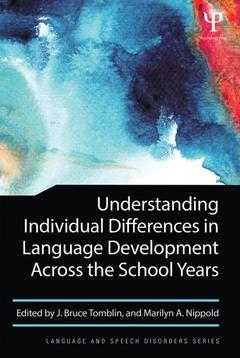Description
Understanding Individual Differences in Language Development Across the School Years
Language and Speech Disorders Series
Coordinators: Tomblin J. Bruce, Nippold Marilyn A.
Language: English
Subjects for Understanding Individual Differences in Language...:
Keywords
language; impairment; speech; pathology; longitudinal; reading; schoolchildren; Nonverbal IQ; Speech Sound Disorder; SLI Group; Li; Iowa Project; Performance IQ Score; Expository Discourse; Language Ability Score; Reading Disability; Ellis Weismer; Performance IQ; Kindergarten Predictors; Phonological Short Term Memory; SLI; Verbal Working Memory; Nonverbal IQ Score; Specific Comprehension Deficit; Poor Phonological Short Term Memory; IRT Score; Previous ERP Study; Total Problems Scores; Nonverbal Cognitive Abilities; Language Impairment Groups; Oral Language Abilities; Working Memory
Publication date: 05-2014
Support: Print on demand
Publication date: 03-2014
Support: Print on demand
Description
/li>Contents
/li>Biography
/li>
This volume presents the findings of a large-scale study of individual differences in spoken (and heard) language development during the school years. The goal of the study was to investigate the degree to which language abilities at school entry were stable over time and influential in the child?s overall success in important aspects of development.
The methodology was a longitudinal study of over 600 children in the US Midwest during a 10-year period. The language skills of these children -- along with reading, academic, and psychosocial outcomes -- were measured. There was intentional oversampling of children with poor language ability without being associated with other developmental or sensory disorders. Furthermore, these children could be sub-grouped based on their nonverbal abilities, such that one group represents children with specific language impairment (SLI), and the other group with nonspecific language impairment (NLI) represents poor language along with depressed nonverbal abilities.
Throughout the book, the authors consider whether these distinctions are supported by evidence obtained in this study and which aspects of development are impacted by poor language ability. Data are provided that allow conclusions to be made regarding the level of risk associated with different degrees of poor language and whether this risk should be viewed as lying on a continuum.
The volume will appeal to researchers and professionals with an interest in children?s language development, particularly those working with children who have a range of language impairments. This includes Speech and Language Pathologists; Child Neuropsychologists; Clinical Psychologists working in Education, as well as Psycholinguists and Developmental Psychologists.
1. Background of the Study, J.B. Tomblin. 2. General Design and Methods, J.B. Tomblin. 3. The Character and Course of Individual Differences in Spoken Language, J.B. Tomblin, M.A. Nippold, M.E. Fey, X. Zhang. 4. Features of Language Impairment in the School Years, J.B. Tomblin, M. Nippold. 5. The Role of Processing in Children and Adolescents with Language Impairment, L.B. Leonard, S.E. Weismer, C. Weber-Fox, C.A. Miller. 6. The Relationship Between Language and Reading Abilities. H.W. Catts, M. Fey, S.E. Weismer, M.S. Bridges. 7. Educational and Psychosocial Outcomes of Language Impairment in Kindergarten, J.B. Tomblin.
J. Bruce Tomblin, Ph.D., CCC-SLP is the D.C. Spriestersbach Distinguished Professor of Liberal Arts and Sciences at the University of Iowa. He is a Fellow and Honors recipient of the American Speech-Language-Hearing Association. He also received the Callier Prize in Communication Disorders. His research has been concerned with the causes, course, and consequences of developmental language impairments. This research has focused on children with specific language impairment and children with hearing loss.
Marilyn A. Nippold, Ph.D., CCC-SLP is Professor of Communication Disorders and Sciences at the University of Oregon where she has taught and conducted research since 1982. She is a Fellow of the American Speech-Language-Hearing Association (ASHA) and served as Editor (2010–2012) of the ASHA journal Language, Speech, and Hearing Services in Schools (LSHSS), which publishes articles that address communication disorders in school-age children and adolescents, including evidence-based intervention studies.




